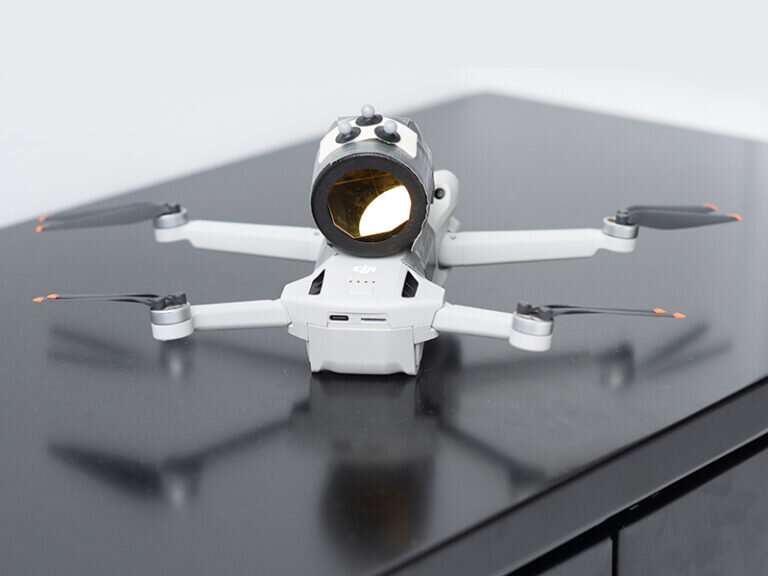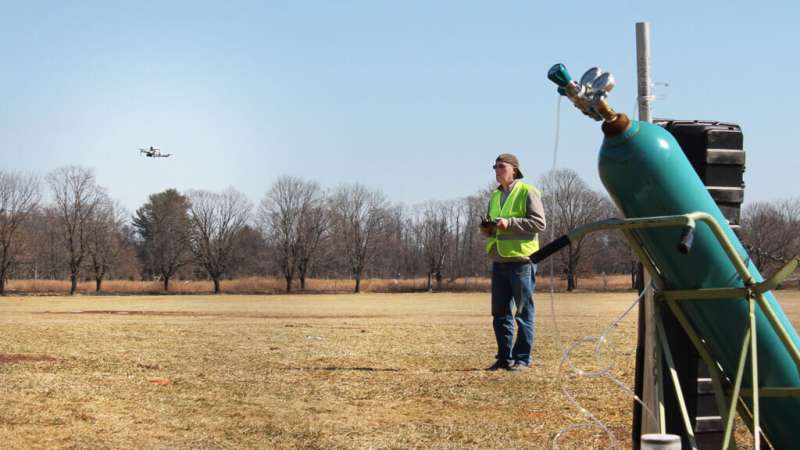This article has been reviewed according to Science X's editorial process and policies. Editors have highlighted the following attributes while ensuring the content's credibility:
fact-checked
trusted source
proofread
Using drones and lasers, researchers pinpoint greenhouse gas leaks

As evidence mounts that gas drilling and sewer systems leak far more greenhouse gases than previously believed, a team of Princeton researchers has developed a method to pinpoint leaks both big and small for speedy repair.
Their laser-based sensing approach, detailed in a paper published in Remote Sensing of Environment, can accurately detect and quantify both large greenhouse gas leaks and leaks up to 25 times smaller than those typically detected at natural gas facilities using other methods, localizing the emissions source to within a meter.
Because it takes advantage of the remote-sensing capabilities of lasers combined with the agility of drones, the new technology can also be used to quickly spot otherwise unseen leaks in hard-to-access areas, an innovation the researchers said unlocks game-changing potential for atmospheric sensing.
"Current approaches for detecting leaks often rely on handheld infrared cameras that are labor-intensive to operate and insensitive to small leaks, or they use methods that require setting up extensive measurement infrastructure ahead of time," said Gerard Wysocki, associate professor of electrical and computer engineering and associated faculty at the Andlinger Center for Energy and the Environment. "But with a drone, you are completely free in how you are able to set up your sensing area."
The researchers' approach consists of a small drone outfitted with only a retroreflector, a type of mirror that reflects incoming light directly back to the source, and a base station of gas sensing equipment with the capability to track the drone's movement during flight. Bouncing a laser beam off the drone as it flies to set points around a suspected leak allows an operator to pinpoint the source of the leak and measure its intensity.
"That's really the holy grail of leak detection," said Mark Zondlo, study co-author, professor of civil and environmental engineering, and associated faculty at the Andlinger Center for Energy and the Environment.
While drone-based techniques for atmospheric sensing exist, they usually require mounting a gas sensor directly onto a drone, a practice that Zondlo said quickly comes up against some major roadblocks related to how much weight a drone can carry and how risky it is to fly a drone overloaded with costly sensors in hazardous environments.

"You really can't fit more than one gas sensor on a drone at a time, otherwise it just becomes too big and bulky to fly. And you probably don't want to risk flying an expensive sensor over the lagoon of a wastewater treatment plant or the flaring of a compressor station," Zondlo said.
Instead of overburdening the drone with sensors, the Princeton group offloaded the expensive gas sensing components to the base station, which can fit on a mobile platform such as a van, meaning that the drone only needed to carry a small mirror. That change allowed the researchers to use smaller, less expensive drones with longer flight times to collect highly detailed emissions data across large areas, potentially unlocking the ability to monitor entire natural gas transmission and distribution facilities in a single drone flight.
"Our approach allows us to bypass the major constraints of using drones and enables us to make full use of their potential," Zondlo said. "It's really a paradigm shift in how we can use drones for atmospheric sensing."
The sensing method could also enable simultaneous measurements of multiple gases, a feat that is exceedingly difficult with other drone-based approaches due to size, weight, and power considerations.
Michael Soskind, the first author of the study and a graduate student in electrical and computer engineering, said adding the ability to measure other gases like carbon dioxide and ammonia alongside methane would be as simple as adding other lasers of different wavelengths to the base system. "All you'd need to do is add a secondary laser to the system," he explained. "The rest of the system is already built out to do the work."
Because it offers users a great amount of flexibility, Wysocki said he sees the team's approach as a technology platform that could spur future innovation and applications beyond methane leak detection.
"The most exciting thing is not simply the methane sensing abilities of the technology we developed," he said. "It's really about unlocking the capability for researchers and practitioners to use drones and other remote sensing techniques to take detailed measurements of small leaks and reconstruct emissions plumes. It's a technology that opens the doors for efficient leak detection and repair, which can help producers mitigate the safety and environmental hazards of those leaks, while also saving them time and money."
More information: Michael G. Soskind et al, Stationary and drone-assisted methane plume localization with dispersion spectroscopy, Remote Sensing of Environment (2023). DOI: 10.1016/j.rse.2023.113513


















